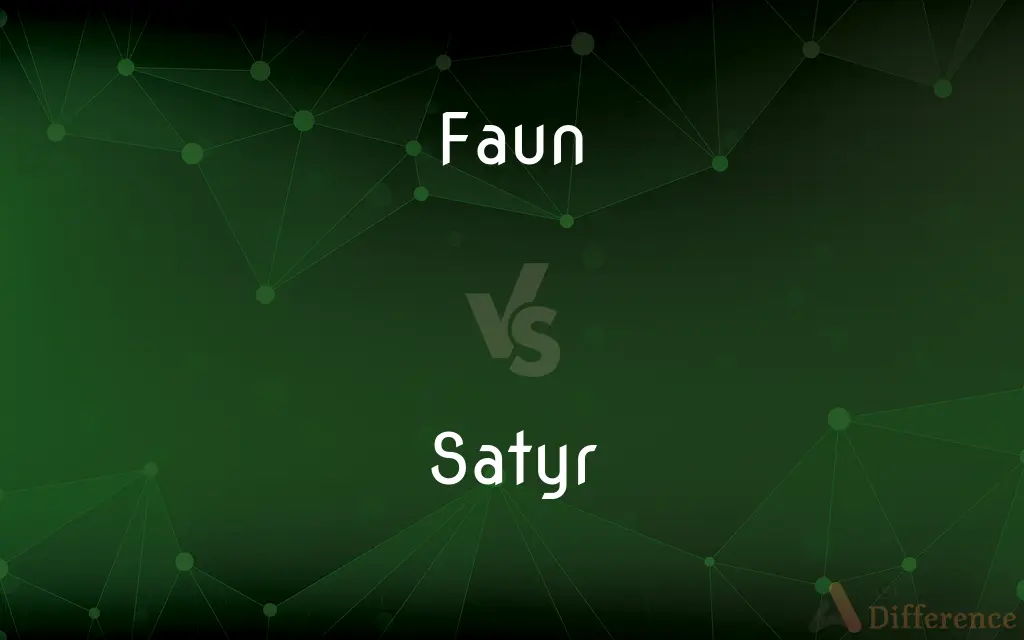Faun vs. Satyr — What's the Difference?
By Tayyaba Rehman — Updated on March 13, 2024
Fauns are Roman mythological creatures with human torsos and goat legs, while Satyrs are their Greek counterparts, often depicted with a more human-like appearance but with animalistic features.

Difference Between Faun and Satyr
Table of Contents
ADVERTISEMENT
Key Differences
Faun and Satyr are often interchanged due to their similarities, but they originate from different mythological traditions. Fauns hail from Roman mythology, whereas Satyrs are of Greek origin.
Both Faun and Satyr are depicted with human upper bodies and the lower bodies of goats. However, while Fauns typically have the features consistent with that depiction, Satyrs, particularly in later Greek art and literature, might exhibit a range of animalistic features, like horse tails or ears.
Fauns are typically associated with the Roman god Pan, the god of shepherds and flocks. Pan himself has goat-like features. On the other hand, Satyrs are often linked with the Greek god Dionysus, the god of wine, fertility, and ritual madness.
In literature and art, Fauns often have a gentler, more pastoral association, reflecting the peaceful nature of the wilderness. Satyrs are sometimes depicted more lasciviously, often seen reveling with Dionysus and embodying the wilder side of nature.
While Faun and Satyr might appear similar at a glance, their cultural origins and the myths surrounding them distinctly separate these two creatures, making them unique entities in their respective mythologies.
ADVERTISEMENT
Comparison Chart
Origin
Roman mythology
Greek mythology
Associated Deity
Pan
Dionysus
Common Depiction
Human upper body, goat lower body
Mostly human-like with varying animalistic features
Typical Characteristics
Gentle, pastoral
Lascivious, wilder side of nature
Contextual Use
Seen in Roman tales and arts
Prominent in Greek plays and arts
Compare with Definitions
Faun
A Roman mythological creature with a human upper body and goat lower body.
The statue depicted a Faun playing a pan flute.
Satyr
Symbolic of the wild, uncontrolled aspects of nature.
The play highlighted the Satyr's wild antics during the Dionysian revels.
Faun
Symbolic of the peaceful wilderness.
She painted a scene with Fauns resting in a serene forest.
Satyr
Often seen in Greek plays and literature.
The character in the story was tempted by a mischievous Satyr.
Faun
Represents nature's gentle side in Roman tales.
Unlike other creatures, the Faun approached the humans without malice.
Satyr
Depicted with a human-like appearance but with some animal features.
The artist's rendition of the Satyr had pronounced goat ears and a horse's tail.
Faun
Often seen playing musical instruments.
The Faun's melody was said to enchant all who heard it.
Satyr
Known for their love of music, dance, and wine.
With a lyre in hand, the Satyr danced joyfully around the bonfire.
Faun
An attendant of the Roman god, Pan.
Legends often spoke of Fauns accompanying Pan in the woods.
Satyr
A creature from Greek mythology, often associated with Dionysus.
The mural showcased a party with Dionysus and several Satyrs in attendance.
Faun
The faun (Latin: faunus, Ancient Greek: φαῦνος, phaunos, pronounced [pʰaunos]) is a mythological half human–half goat creature appearing in Roman mythology. The goat men, more commonly affiliated with the Satyrs of Greek mythology than the fauns of Roman, are bipedal creatures with the legs and tail of a goat and the head, torso, and arms of a man, and are often depicted with goat's horns and pointed ears.
Satyr
In Greek mythology, a satyr (Greek: σάτυρος, translit. sátyros, pronounced [sátyros]), also known as a silenus or silenos (Greek: σειληνός seilēnós [seːlɛːnós]), is a male nature spirit with ears and a tail resembling those of a horse, as well as a permanent, exaggerated erection.
Faun
Any of numerous rural deities represented as having the body of a man and the horns, ears, tail, and sometimes legs of a goat.
Satyr
Often Satyr Greek Mythology A woodland creature depicted as having the pointed ears, legs, and short horns of a goat and a fondness for unrestrained revelry.
Faun
(Roman mythology) A woodland creature with pointed ears, legs, and short horns of a goat and a fondness for unrestrained revelry.
Satyr
A licentious man; a lecher.
Faun
(entomology) Any of various nymphalid butterflies of the genus Faunis.
Satyr
A man who is affected by satyriasis. No longer in clinical usage.
Faun
A god of fields and shipherds, diddering little from the satyr. The fauns are usually represented as half goat and half man.
Satyr or Faun, or Sylvan.
Satyr
Any of various satyrid butterflies having brownish wings marked with eyespots.
Faun
Ancient Italian deity in human shape, with horns, pointed ears and a goat's tail; equivalent to Greek satyr
Satyr
(Greek mythology) A sylvan deity or demigod, male companion of Pan or Dionysus, represented as part man and part goat, and characterized by riotous merriment and lasciviousness, sometimes pictured with a perpetual erection.
Satyr
(Roman mythology) faun
Satyr
(by extension) A lecherous man.
Satyr
Any of various butterflies of the nymphalid subfamily Satyrinae, having brown wings marked with eyelike spots; a meadow brown.
Satyr
(obsolete) The orangutan.
Satyr
A sylvan deity or demigod, represented as part man and part goat, and characterized by riotous merriment and lasciviousness.
Rough Satyrs danced; and Fauns, with cloven heel,From the glad sound would not be absent long.
Satyr
Any one of many species of butterflies belonging to the family Nymphalidæ. Their colors are commonly brown and gray, often with ocelli on the wings. Called also meadow browns.
Satyr
The orang-outang.
Satyr
One of a class of woodland deities; attendant on Bacchus; identified with Roman fauns
Common Curiosities
How are Fauns typically portrayed in mythology?
They are often seen as gentle creatures of the wilderness, symbolizing nature's peaceful side.
Are Fauns and Satyrs the same creature?
No, while similar, they come from different mythological traditions and have distinct characteristics.
Can I use Faun and Satyr interchangeably in literature or conversation?
Though similar, using them interchangeably might not be accurate due to their distinct mythological backgrounds.
Do both Fauns and Satyrs have a connection with music?
Yes, both are often depicted with musical instruments and have musical associations in myths.
How are Satyrs typically perceived in Greek tales?
They often embody the wild and uncontrolled side of nature and are seen reveling with Dionysus.
Who do Satyrs often accompany in Greek tales?
Satyrs are commonly seen with Dionysus, the Greek god of wine.
What's the primary origin difference between Faun and Satyr?
Faun originates from Roman mythology, while Satyr comes from Greek mythology.
Which deity is the Faun commonly associated with?
Fauns are associated with the Roman god Pan.
How do Satyrs differ in appearance from Fauns?
While both have human and goat features, Satyrs in later Greek art might have more varied animalistic traits.
Are there any other creatures similar to Fauns and Satyrs in world mythologies?
Various mythologies have half-human, half-animal beings, but Fauns and Satyrs are specific to Roman and Greek tales, respectively.
Share Your Discovery

Previous Comparison
Thermocouple vs. Thermometer
Next Comparison
Prospective vs. PerspectiveAuthor Spotlight
Written by
Tayyaba RehmanTayyaba Rehman is a distinguished writer, currently serving as a primary contributor to askdifference.com. As a researcher in semantics and etymology, Tayyaba's passion for the complexity of languages and their distinctions has found a perfect home on the platform. Tayyaba delves into the intricacies of language, distinguishing between commonly confused words and phrases, thereby providing clarity for readers worldwide.
















































